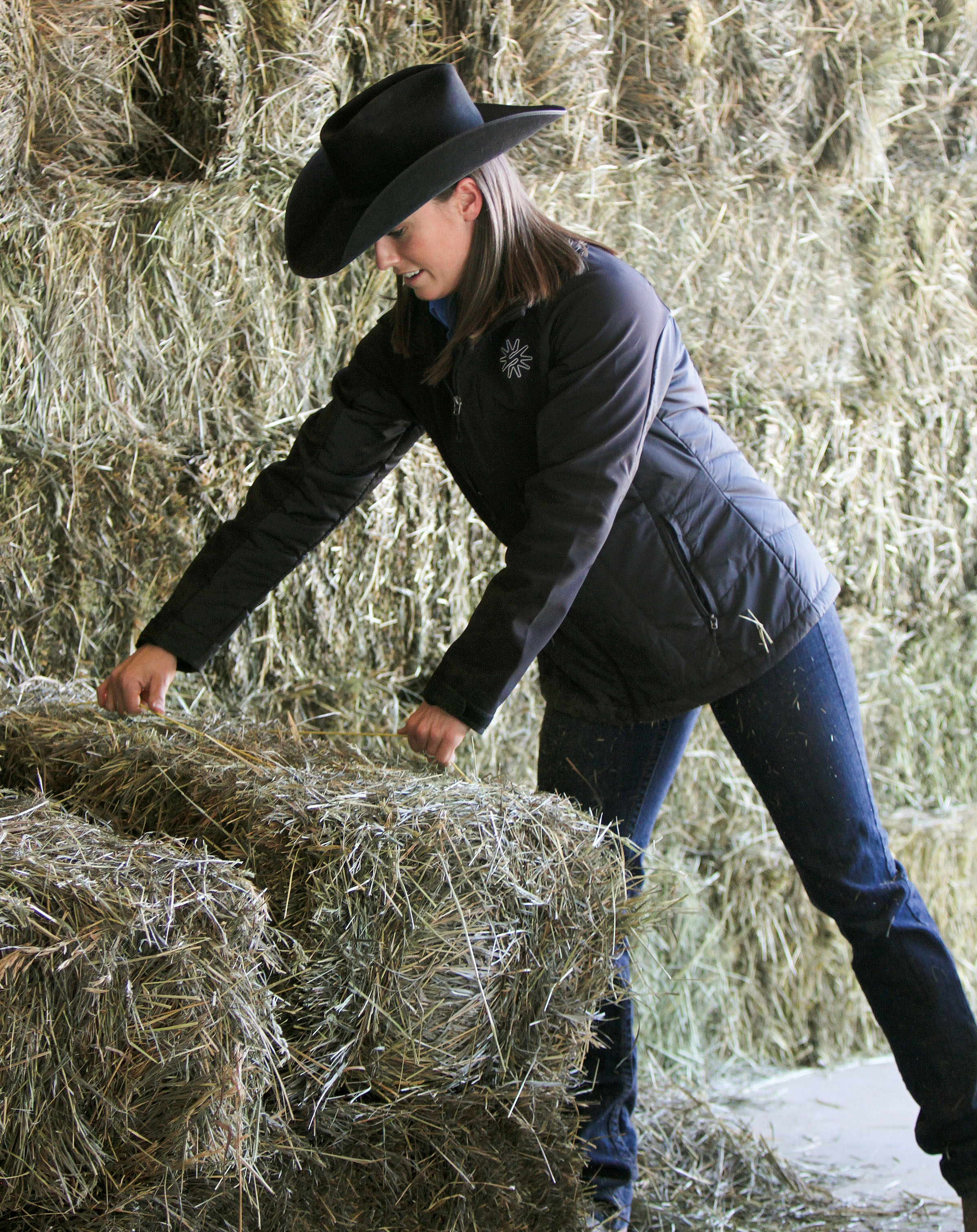
Riding takes coordination, balance, strength, and stamina; riding well asks even more of you as a rider. It requires horsemanship skill, as well as a foundation of overall fitness so you can keep up with your horse, cue and steer, and school him. If you’re not physically and mentally up to the challenge, then you hinder your horse’s growth as an athlete and your own development as a rider. This holds you back from achieving your riding-related goals.
[READ: Be Equestrian Fit]
If you want to step up your riding, or just get back to baseline after a break, taking your personal fitness seriously gets you there faster and safely. Here we identify the five most common fitness-related inhibitors that stunt riding success. You’ll learn how each affects your in-saddle effectiveness, and then how to remedy the problem with exercise. Plus we’ll provide a saddle-ready circuit to get you moving at home or at the barn—no gym membership required.
Inhibitor #1
You lack physical strength.
The Solution: Improve power and endurance.
Even fit riders experience post-ride soreness following a particularly long, grueling session. But routine soreness means you lack muscular strength. Another weakness indicator is that you find it difficult to maintain good posture, drive your horse forward, cue effectively, or stay balanced in the saddle. Weakness is more than a fitness problem if it affects your riding; it’s a horsemanship deficiency.
Riding strength all starts with a strong core. Your abs and lower back keep you upright, balanced, and stable. Core strength keeps you balanced in the saddle as your horse maneuvers a powerful rollback, ascends a steep hill, or spooks suddenly. Along with muscular strength, endurance allows you to drive your horse forward for extended periods or in involved gaits, such as the extended trot or posting without stirrups.
Your glutes, hamstrings, and hips also help drive your horse forward and support your core. They’re responsible for the forward and backward movement of your leg to cues. The insides of your legs, or adductors, squeeze and grip the saddle so you can ride with cadence, rather than bounce around as you trot.
Your shoulders, upper back, and the muscles along your spine and lower back help you maintain your athletic in-saddle posture: upright, chest up, and shoulders back. Proper posture creates eye-appeal in the arena, but more importantly it keeps your weight distributed in the center of your saddle. If your weight is too far forward, either because your shoulders are slouched or you’re upright but with an excessive forward lean, your weight distributes over your horse’s shoulders and throws off his balance. He’s unable to achieve the long stride and rear-end impulsion that you look for. A forward seat also tilts your hips down, making it difficult for you to use them to drive your horse forward for lengthened stride or increased speed. If you lean too far back because you can’t sit upright, you put yourself out of position to cue with your legs, drive with your hips, and stay balanced as your horse moves.
As you work to build muscular strength, be mindful of balance as you exercise. Your strength and flexibility should be complementary on both sides of your body, and from front to back. If one of your hips is stronger or more flexible than the other, your cues and seat will be uneven, leading to imbalances in your horse over time. If you don’t have time to go to the gym, you can improve your strength and endurance at home through timesaving, tabata-style workouts. See “Saddle-Ready Routine” on pages 64 and 66, and then visit facebook.com/westernworkouts for more rider-fitness tips. Regardless of where you workout, find a routine that’s fun, challenges you, and that you can stay consistent with.
Saddle-Ready Routine
Horse people are busy, and some days it’s impossible to make it to the gym. Here’s a quick and effective full-body, high-intensity interval training (HIIT) workout you can complete at home. Use a tack box, tractor tire, bale of hay, water tank, or any sturdy implement that can hold your bodyweight for your step-ups and dips.
Start with three rounds of the first circuit, and then three rounds of the second circuit. Rest one minute between each round and between each circuit. Complete as many repetitions of each exercise as you can in the allotted time.

Circuit One
60 Seconds: Toe Taps
Get warmed up with one minute of toe-tapping to prepare your body for exercise.

30 Seconds: Push-Ups
Start with your hands shoulder-width apart and directly below your shoulders, legs straight out behind you, and toes tucked. Lower toward the ground until your chest touches your implement, and then push back up to start. Keep a tight, activated core and flat back (no sagged hips or poked-up butt) through the movement. If you struggle to maintain proper form, complete the same series with your knees on the ground instead.

30 Seconds: Tricep Dips
With your hands shoulder-width apart on a stable object behind you, and your legs extended in front of you, lower your rear toward the ground. The goal is to reach a depth that achieves 90-degree elbow bend, but only lower as far as your arms can push yourself up from.

30 Seconds: Spider Plank
Start in a push-up position. Hold this position as you alternate reaching your same-side knee to your elbow. Complete the exercise on an elevated object to make the movement easier.
Circuit Two
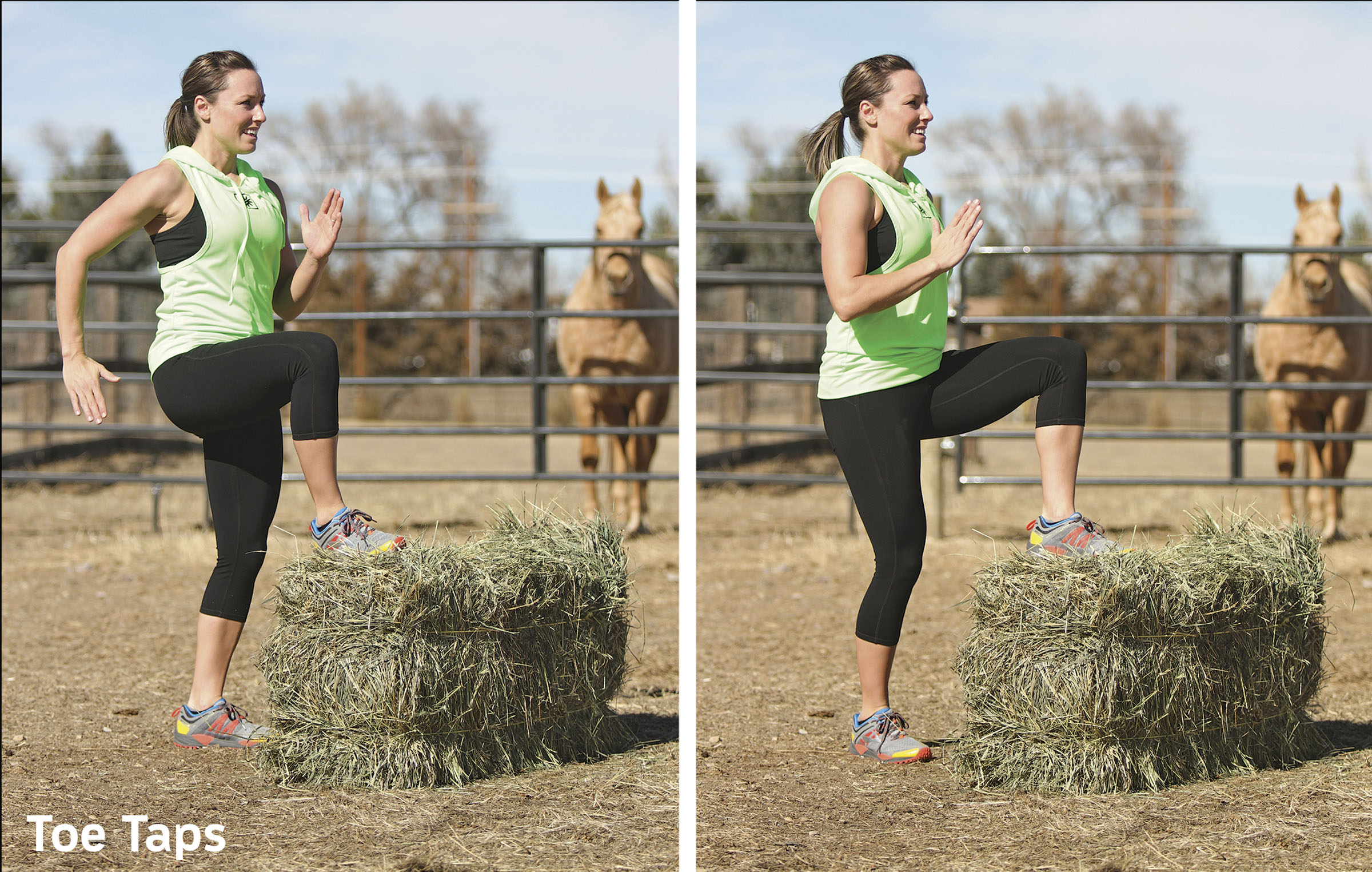
60 Seconds: Toe Taps
Start again with toe-tapping on your implement to prepare your body for exercise.
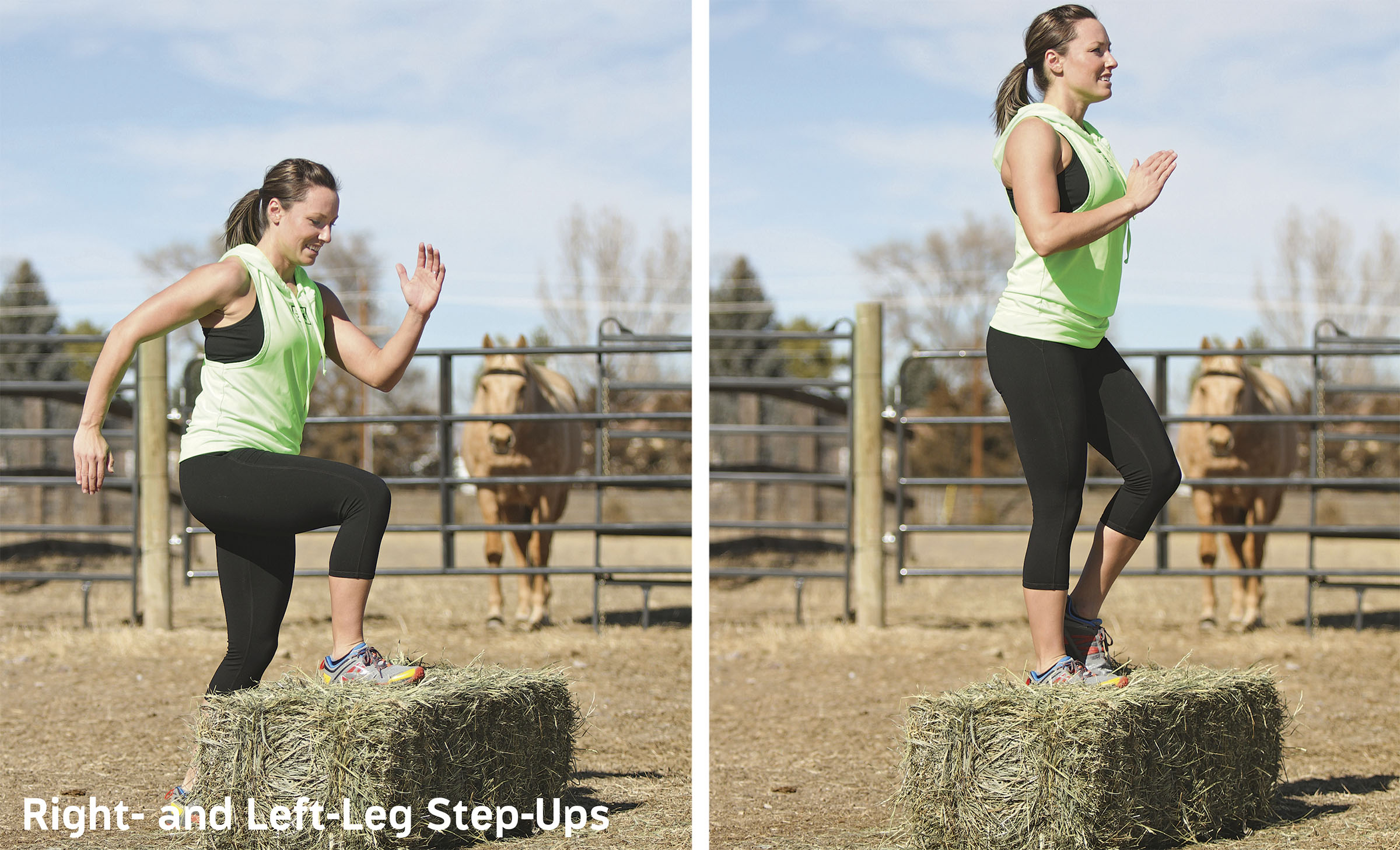
30 Seconds: Right- and Left-Leg Step-Ups
Complete on objects of various heights. Squeeze through your glutes as you step up. To maximize the benefit of the exercise, don’t place your hands on your step-leg to pull your trail-leg up.
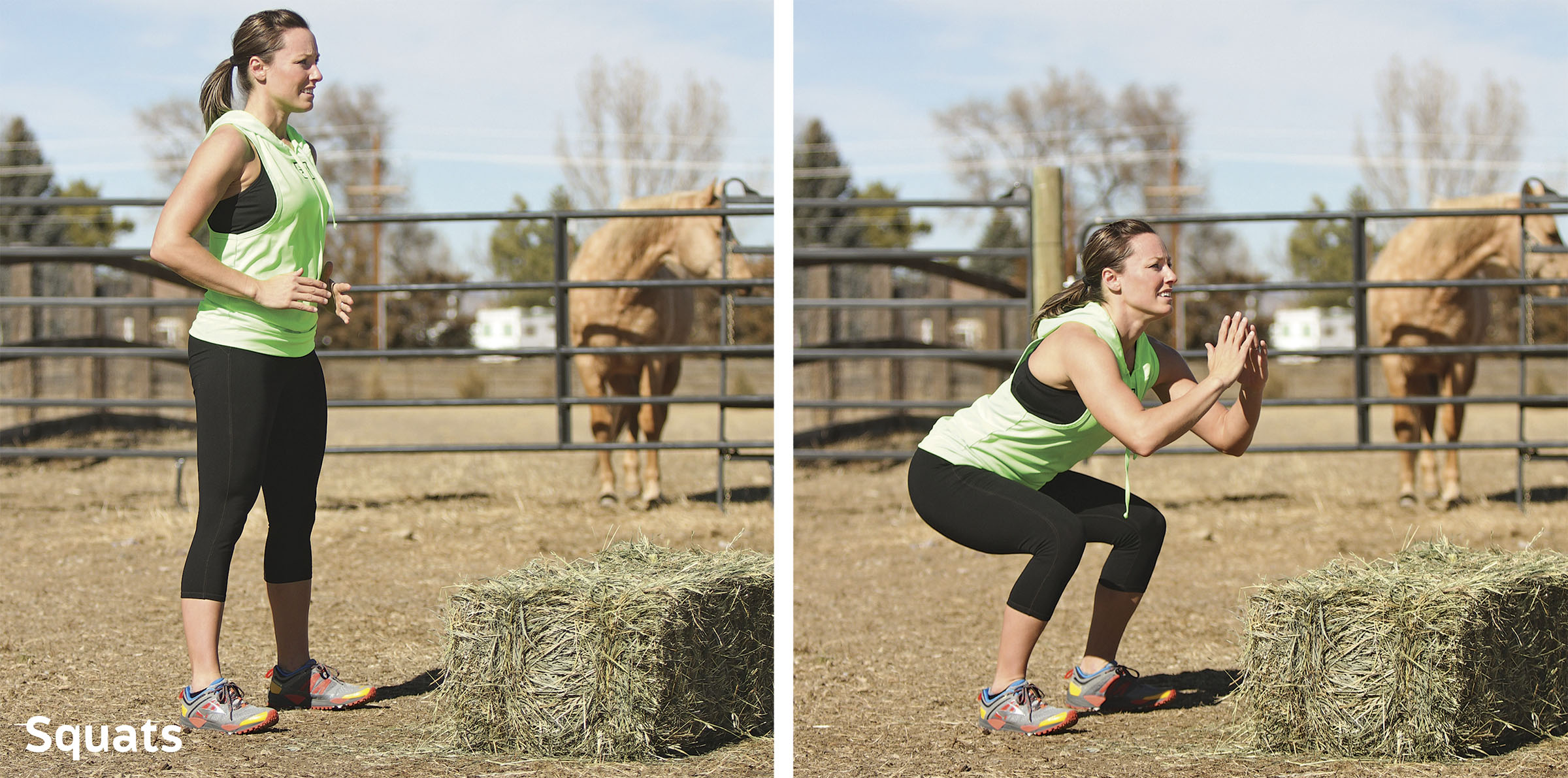
30 Seconds: Squats
Squat, start with your feet hip-width apart, and lower yourself as deeply into the squat as possible while in the correct position. Like riding, your heels are down (in contact with the ground) and your chest is upright.
Inhibitor #2
You lack coordination and body and spatial awareness.
The Solution: Use complex exercises.
Riding requires that you understand where your body is in relation to your horse and where your horse is in space. Your hands and feet must also act simultaneously, but separately, as you steer, maintain or change speed, and navigate obstacles inside or outside the arena. If you struggle to do this well, you give your horse mixed signals.
Most exercises incorporate the entire body, use weights or other tools, or require a combination of both. As you complete an exercise properly, you learn to be mindful of where your body is in space and where the weight is in relation to your body. You focus to move your legs or arms independently and brace with your core to successfully execute a specific movement, and you get better at it with practice. Mastery of this skill in the gym improves coordination as you ride. Your ability to simultaneously steer with your hands, cue with your feet, and stabilize with your core becomes better.
To complete a pattern at a show you must assess the size of the arena, determine where the markers are, and then plan how you’ll execute maneuvers to scale and in relation to those markers. The same rule applies in a trail pattern, on a trail ride, or with cattle; you must be able to gauge distance accurately to be successful. Spatial awareness improves through complex exercises in the gym, and especially non-bodyweight movements that require equipment. You must be aware of where the barbell, dumbbell, or medicine ball is in relation to yourself as you move. You get comfortable with these tools as you use them, and your spatial awareness and overall athleticism improves.
Inhibitor #3
You lack stamina.
The Solution: Increase mental and physical resilience.
Horse ownership takes mental and physical fortitude. Early mornings and late nights at shows and on trail rides make for long, tiring days. Consider the amount of time you spend in the saddle and at an event during a long show day (or weekend). If you’re entered in several classes in a day, or a class with 100 entries or multiple splits, you need stamina to maintain energy and focus to ride well, sit tall, and smile. Trail riders who enjoy long, challenging routes must be attentive and able to withstand extended periods in the saddle to keep up with the group.
A body responds to resistance no matter your age or gender. High-intensity workouts and training give your muscles the resistance needed to grow, adapt, and become stronger. You’ll be sore initially, but like your horse, as you continue to condition yourself, your endurance increases and you experience less fatigue and post-exercise discomfort. Resilience develops through consistency. Create a routine that allows you to gradually progress. If you’re starting at zero, then one additional workout day per week will make a noticeable difference in your fitness level. The goal is to not burn out before good habits develop. So, it’s better to start small, with two to three exercise days per week every week, than to workout every day for one or two weeks, and then get tired and give up.
The mental benefits of exercise also give you a competitive edge in your riding. You go to the gym because you know it’s good for you, but determination helps you finish your routine. Exercise teaches you to push yourself even when you’re tired. This prepares you to handle an unexpected stressor at a show or to endure a long day or trip with your horse. You approach the situation confidently, knowing you have the mental stamina to push yourself through to the end.
Exercise is also a great stress reliever. It’s an outlet to release negative emotion and pent up energy. This, coupled with a post-workout endorphin rush, alleviates tension. And, if you’re less tense, you’re free to focus on your horse as you ride, instead of worry about everything else.
Inhibitor #4
You lack flexibility and mobility.
The Solution: Prep before and recover after your ride.
Strength and endurance increase as you exercise, but if your muscles are tight and inflexible, it inhibits your riding. Just like a horse with tight shoulders can’t move freely, muscle tightness reduces your range of motion. If your hips are tight, it’s difficult to move your legs to cue your horse well. Or, if your back is tight, it tires quickly and you lose the stamina needed to drive your horse forward in a gait.
To avoid this, stretch before you ride. It alleviates stiffness and soreness, and preps your body to work. The single-leg chair stretch demonstrated on page 70 is my preferred pre-ride, hip-opening stretch. A quick bodyweight warm up also reduces pre-ride tightness and post-ride soreness. Complete three sets of five air squats before you saddle up to warm up your body, set your hips evenly, and activate your muscles. To perform a controlled squat, start with your feet hip-width apart, and lower yourself as deeply into the squat as possible while in the correct position. Like riding, your heels are down (in contact with the ground) and your chest is upright. As soon as form breaks down—your chest caves in, your heels come up, or your back rounds—you’ve reached your squat-depth stopping point. Over time the depth of your squat improves, as will your comfort in your riding seat.
Allow yourself time to cool down and stretch after each ride or workout session. This speeds up recovery and saves you the discomfort of your muscles shortening, tightening, and then cramping.
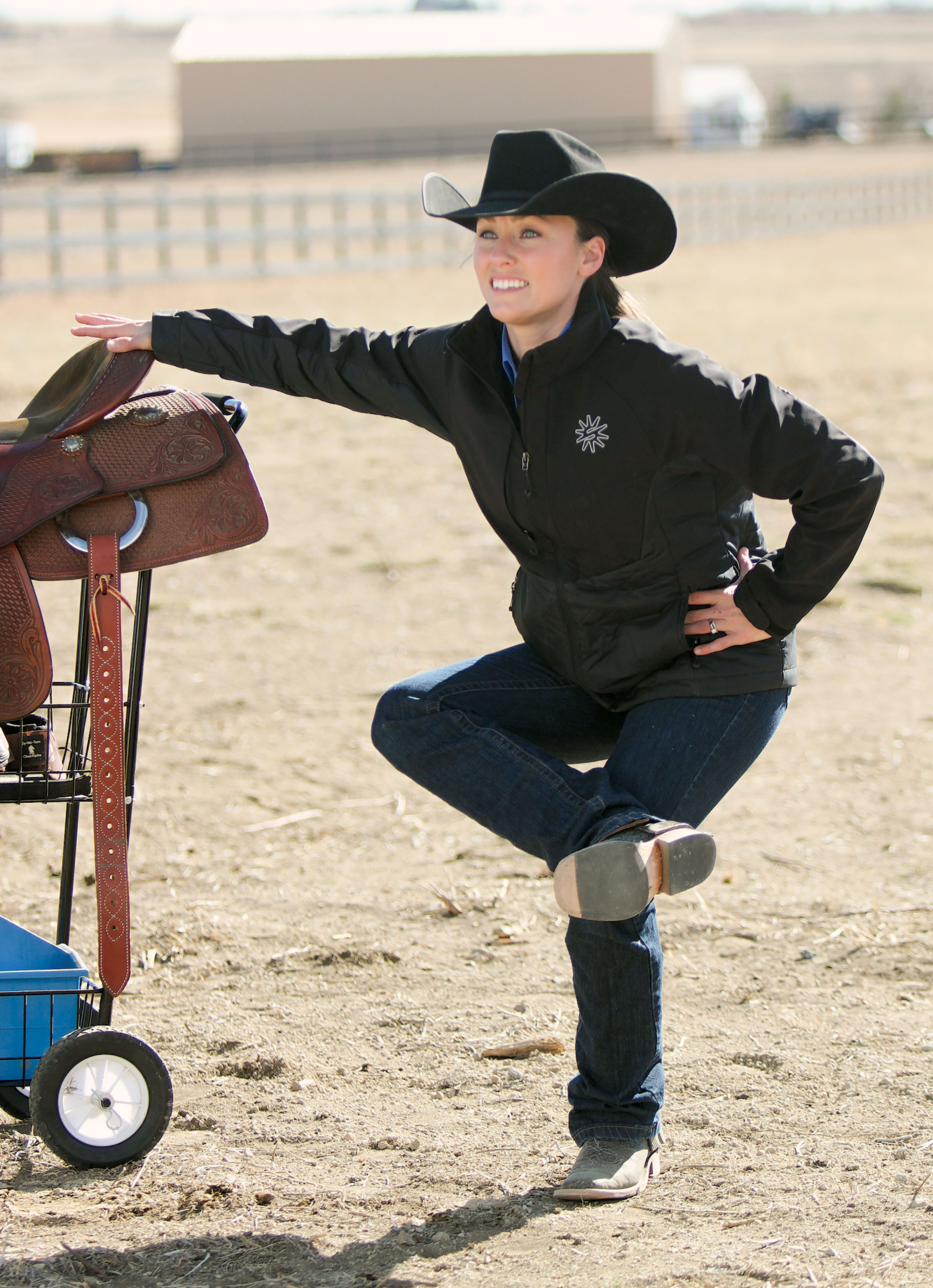
Inhibitor #5
You lack confidence in your physical ability.
The Solution: Improve self-assuredness.
Riding is part skill and part confidence. If you lack confidence in your carriage, in your presentation, or in your physical capability, it shows in your riding. You’ll ride timidly and will always feel out of sync with your horse. Both of which stunt your horse’s growth. You’ll be unable to school him when necessary, push him to reach his full potential, or show him to his ability.
Confidence is also about quality of life, not just performance and appearance. If you know you lack the leg strength to stay seated during a rollback or a spook, you’ll worry about these maneuvers while you ride. Exercise improves your strength and balance, which will improve your confidence. You’ll be sure that you can stay seated no matter what your horse throws at you, and you’ll be able to ride assertively.
If you’re an older rider who lacks strength and resilience, you might worry that you’ll be able to hold your bodyweight on one leg as you mount or dismount, and are even more nervous if your horse fidgets. Resistance training improves bone density and physical hardiness, which enables you to bear the physical demands to care for and ride your horse. As you age, you must be contentious to stay physically fit so you can continue to enjoy your horse without fear.
Self-confidence is also about physical appearance. Aside from improved quality of horse life, exercise helps you look better in your show outfit. You’ll have less overall movement because your body is strong and firm. And, if you know you look good, you’ll radiate confidence in the arena, and earn yourself top marks.
Kelly Altschwager lives in Wellington, Colorado, with her husband, Andy, and two sons, Cash and Cole. She’s an ACE-certified personal trainer and nutrition specialist; PiYo instructor; fitness expert at Fitness1 Club Wellington; and owns and operates Western Workouts, a personal-training service geared toward helping the busy horseperson. Western Workouts provides short, high-intensity routines that use everyday implements for fitness around the home. Learn more at westernworkouts.com.






